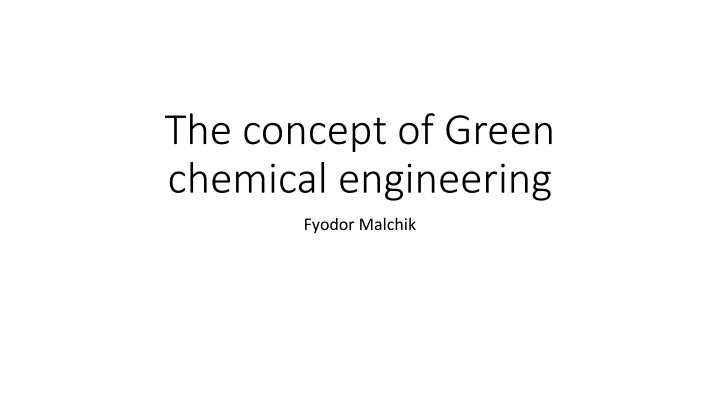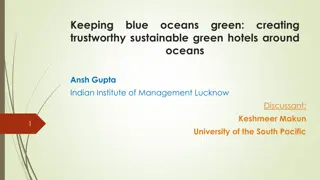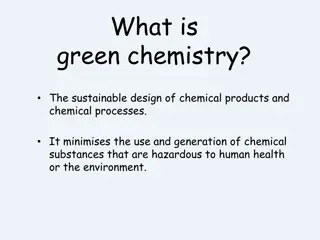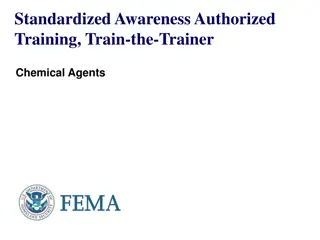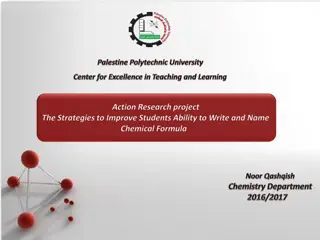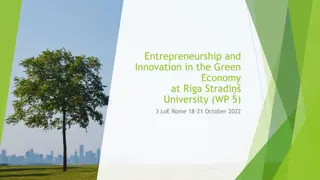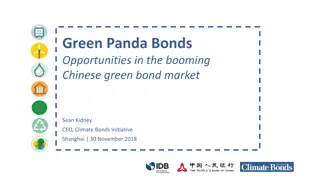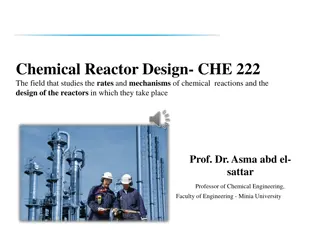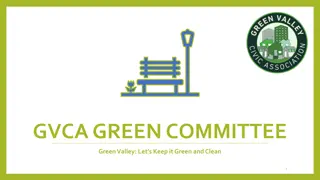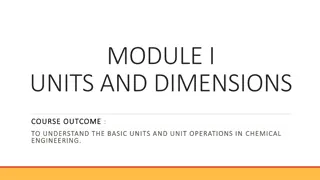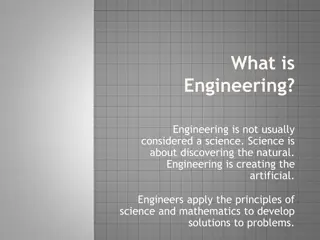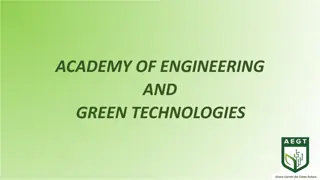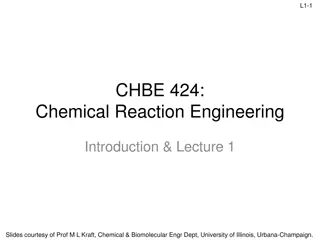Green Chemical Engineering Overview
Concept of green chemical engineering by delving into topics such as green engineering definition, inherent safety principles, environmentally-conscious process design methodologies, energy use in U.S. industries, pollution prevention vs. pollution control, and examples of green engineering applications.
Download Presentation

Please find below an Image/Link to download the presentation.
The content on the website is provided AS IS for your information and personal use only. It may not be sold, licensed, or shared on other websites without obtaining consent from the author.If you encounter any issues during the download, it is possible that the publisher has removed the file from their server.
You are allowed to download the files provided on this website for personal or commercial use, subject to the condition that they are used lawfully. All files are the property of their respective owners.
The content on the website is provided AS IS for your information and personal use only. It may not be sold, licensed, or shared on other websites without obtaining consent from the author.
E N D
Presentation Transcript
The concept of Green chemical engineering Fyodor Malchik
Presentation Outline Introduction to Green Engineering (GE) and Inherent Safety (IS) GE definition, concepts, principles, and tools IS concepts and tools Similarities and differences between GE and IS Environmentally-Conscious Process Design Methodology A hierarchical approach with three tiers of impact assessment A case study for maleic anhydride (MA) process design Early design methods and software tools Flowsheet synthesis, assessment, and software tools Flowsheet optimization - comparison of process improvement Summary of environmentally-conscious design methods 2
What is Green Engineering? Design, commercialization and use of processes and products that are feasible and economical while minimizing: + Risk to human health and the environment + Generation of pollution at the source 3
Energy Use: U.S. Industry SIC Code 1015 BTU/yr 29 Petroleum/Coal Products 28 Chemicals / Allied Products 26 Paper / Allied Products 33 Primary Metals Industries 20 Food / Kindred Products 32 Stone,Clay and Glass 24 Lumber / Wood Products 6.34 5.33 2.67 2.46 1.19 0.94 0.49 Numbers represent roughly the % of US annual energy consumption Annual Energy Review 1997, U.S. DOE, Energy Information Administration, Washington, DC, DOE/EIA-0384(97) 4
Pollution Prevention (P2) vs. Pollution Control (PC) Traditional Process Products Raw Materials, Energy Chemical Process Pollution Control Wastes Greener Process Higher income, Higher operating costs Products Raw Materials, Energy Modified Chemical Process Pollution Control Lower PC costs Wastes Recycle 5
Examples of Green Engineering Chemical reactions using environmentally-benign solvents Improved catalysts that increase selectivity and reduce wastes that improve product quality and reduce environmental impacts that process wastes into valuable products Separations using supercritical CO2 rather than R-Cl solvents Separative reactors that boost yield and selectivity Fuel cells in transportation and electricity generation CO2 sequestration New designs that integrate mass and energy more efficiently Process modifications that reduce emissions Environmentally-conscious design methods and software tools. 6
Environmentally-Conscious Design Methods and tools to evaluate environmental consequences of chemical processes and products are needed. quantify multiple environmental impacts, guide process and product design activities improve environmental performance of chemical processes and products Environmental impacts energy consumption impacts to air, water human health impacts - raw materials consumption - solid wastes - toxic effects to ecosystems Economic Performance costs, profitability 7
Tools of Environmentally-Conscious Chemical Process Design and Analysis Chemical Process Properties thermodynamics reactions transport Chemical Process Models simulation waste generation and release Environmental Fate Properties databases estimation Environmental Fate Models single compartment multi-media E-CD Environmental Impacts Models midpoint vs endpoint normalization valuation Hierarchical Design Process Optimization multi-objective mixed integer non-linear Process Integration mass integration heat integration 8
Principles of Green Engineering The Sandestin Declaration on Green Engineering Principles Green Engineering transforms existing engineering disciplines and practices to those that lead to sustainability. Green Engineering incorporates development and implementation of products, processes, and systems that meet technical and cost objectives while protecting human health and welfare and elevates the protection of the biosphere as a criterion in engineering solutions. Green Engineering: Defining the Principles, Engineering Conferences International, Sandestin, FL, USA, May 17-22, 2003. 9
Principles of Green Engineering The Sandestin GE Principles 1. Engineer processes and products holistically, use systems analysis, and integrate environmental impact assessment tools. 2. Conserve and improve natural ecosystems while protecting human health and well- being 3. Use life-cycle thinking in all engineering activities 4. Ensure that all material and energy inputs and outputs are as inherently safe and benign as possible 5. Minimize depletion of natural resources 6. Strive to prevent waste 7. Develop and apply engineering solutions, while being cognizant of local geography, aspirations, and cultures 8. Create engineering solutions beyond current or dominant technologies; improve, innovate and invent (technologies) to achieve sustainability 9. Actively engage communities and stakeholders in development of engineering solutions Green Engineering: Defining the Principles, Engineering Conferences International, Sandestin, FL, USA, May 17-22, 2003. 10
Definition of Inherent Safety (IS) A chemical manufacturing process is described as inherently safer if it reduces or eliminates hazards associated with materials used and operations, and this reduction or elimination is a permanent and inseparable part of the process technology. (Kletz, 1991; Hendershot, 1997a, b) 11
IS Concepts Intensification - using less of a hazardous material Example: improved catalysts can reduce the size of equipment and minimize consequences of accidents. Attenuation - using a hazardous material in a less hazardous form. Example: larger size of particle for flammable dust or a diluted form of hazardous material like aqueous acid rather than anhydrous acid. Substitution - using a safer material or production of a safer product. Example: substituting water for a flammable solvent in latex paints compared to oil base paints. 12
IS Concepts (cont.) limitation - minimizing the effect of an incident. Example: smaller diameter of pipe for transport of toxic gases and liquids will minimize the dispersion of the material when an accident does occur Simplification - reducing the opportunities for error and malfunction. Example: easier-to-understand instructions to operators. 13
Comparison between IS and (GE) Strategy/Tenet (Based on IS) Inherent Safety (IS) Green Example Concepts Engineering (GE) Reaction chemistry, Feedstocks, Catalysts, Solvents, Fuel selection Substitution Process Intensification, Recycle, Inventory reduction, Energy efficiency, Plant location Minimization Number of unit operations, DCS configuration, Raw material quality, Equipment design Simplification Conversion conditions, Storage conditions, Dilution, Equipment overdesign Moderation (1) [Basic Process] Offsite reuse, Advanced waste treatment, Plant location, Beneficial co- disposal Moderation (2) [Overall Plant] = Primary tenet/concepts = Strongly related tenet/concepts = Some aspects addressed = Little relationship 14
Similarities between (GE) and (IS) Benign and less hazardous materials. Both focus on process changes. Improving either one often results in improving the other. Both use a life-cycle approach. Both are best considered in the initial stages of the design. 15
Differences between GE & IS Focus on a different parts of the product life cycle. Focus on different aspect of EHS (environmental, health and safety) field and may conflict in application. Environmental impacts are more numerous than safety impacts. 16
Presentation Outline Introduction to Green Engineering (GE) and Inherent Safety (IS) GE definition, concepts, principles, and tools IS concepts and tools Similarities and differences between GE and IS Environmentally-Conscious Process Design Methodology A hierarchical approach with three tiers of impact assessment A case study for maleic anhydride (MA) process design Early design methods and software tools Flowsheet synthesis, assessment, and software tools Flowsheet optimization - comparison of process improvement Summary of environmentally-conscious design (ECD) methods 17
Scope of environmental impacts Chemical Pre-Chemical Manufacturing Stages Post-Chemical Manufacturing Stages Manufacturing Process Chemical reactions Separation operations Material storage Loading and unloading Material conveyance Waste treatment Final product manufacture Product usage in commerce Reuse/recycle Treatment/destruction Disposal Environmental release Extraction from the environment Transportation of materials Refining of raw materials Storage and transportation Loading and unloading processes Airborne releases wastewater releases Solid/hazardous waste Toxic chemical releases Energy consumption Resource depletion Environmental/Health Impacts Global warming Ozone layer depletion Air quality smog Acidification Ecotoxicity Human health effects, carcinogenic and non carcinogenic Resource depletion 18
Tools of Environmentally-Conscious Chemical Process Design and Analysis Chemical Process Properties thermodynamics reactions transport Chemical Process Models simulation waste generation and release Environmental Fate Properties databases estimation Environmental Fate Models single compartment multi-media E-CD Environmental Impacts Models midpoint vs endpoint normalization valuation Hierarchical Design Process Optimization multi-objective mixed integer non-linear Process Integration mass integration heat integration 19
